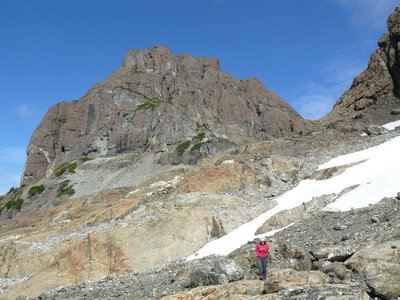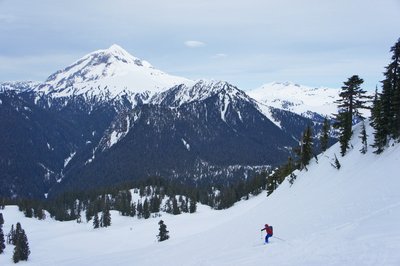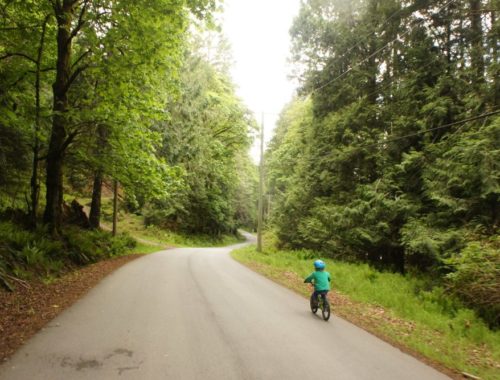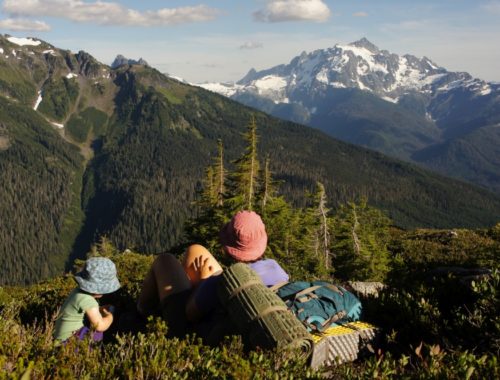
Red Pillar: Discovering the Mountains of Vancouver Island
I thought there were no glaciers on Vancouver Island. Perhaps our last trip on the Island, to Mt. Albert Edward, should be blamed: we arrived to the summit in thick fog, and could barely see each other, not to mention peaks and glaciers. Like many others, from then on I assumed Vancouver Island was mostly trees, with perhaps a few pieces of rock sticking out here and there above the treetops.

This time the weather called for sun, and a close look at a map of Strathcona Provincial Park revealed many large glaciers close by. We packed our backpacks on Friday and took an evening ferry to Vancouver Island. We stayed with our friends Jan and Warrick who live near Duncan. My brother Tal, who was visiting from Israel, also joined us. The next day we woke up early and began the long drive. Except for Warrick, most of us slept soundly, until we were awoken at Cathedral Grove. As if in a dream, we walked along the trail bleary eyed amongst the 800 year old Douglas Firs, the largest of which has a diameter of 9 meters.
Soon enough we were back in the car dreaming sweet dreams. We passed through Port Alberni, and drove a long way on the gravel Ash River Road to the southern end of Oshinow Lake. There we unloaded Jan and Warrick’s two canoes, loaded our packs and began the 5km paddle to the north end of the lake. Here the differences in technique between pure beginners (us) and seasoned canoers (our friends) was apparent. Their canoe made a straight course, while ours meandered like a drunk sailor shuffling across a bar room. This was the first time I had started a hike with a canoe crossing, but I like the idea: besides the obvious advantage of using different muscles, the additional hassle of owning or borrowing a canoe and getting it to the trail head means that canoe accessed trails are inherently unpopular, and hence attractive.

We canoed a short way up the creek that flows into Oshinow Lake and hauled the canoes up onto higher ground, remembering to tie them in case the river level would rise. We had lunch, hiding from the rain under some trees. From there we followed the trail, which had many blown down trees in the first part. These obstacles often required getting down on all four or hopping over the trunks, but they weren’t too bad. We were glad we had put on our rain pants since the vegetation was completely wet from the previous night’s rain. The trail followed the creek for maybe two kilometers, and then headed uphill through the forest. This section had much less blow downs, and soon enough we reached open forest with thin underbrush. We saw some large and impressive trees, and many colourful mushrooms. The few blueberries that we found had flavors that ranged from ketchup and mustard to completely gross.
The trail headed uphill steeply, not bothering with switchbacks. This section was so heavily flagged that I collected two pockets full of orange flagging I found on the ground, and still there was lots to be seen all around. We took a few stops, enjoying the deluxe trail mix my brother had made – 1kg of dried mango and guava, Haribo gummy bears, chocolate chips, pretzels, and roasted soy beans. At one point we passed a wasp’s nest, and several of us were stung, one in the head. Finally we broke out of the trees onto an open ridge. The clouds prevented us from seeing much of a view and there was a cold wind in the air. Luckily there were several large tarns, so that we had plenty of water. We found a campsite with some protection from the wind, and sat down for our long awaited dinner. We said our good nights, noticing many stars, and holding fingers that the next day would be nicer.
I woke up to a chilly morning, a frost covered tent, and clear views of the Red Pillar right behind our tent. The light from the sunrise made it look a dark red, and the last section seemed steep and imposing. After breakfast we set out, following the ridge north towards the Red Pillar. South we could see a sea of clouds, which I imagined to be a huge flat ice sheet – perhaps this is what the area looked like during the last ice age, 20,000 years ago. We enjoyed clear views of the glaciated Septimus, Rosseau and Nine Peaks to the south west.
We followed the ridge crest, picking up short sections of faint trail and passing a few small cairns. Jan’s knees were not doing too well, and she decided to stay back. We continued along the ridge, going down into a small notch and then skirting to the left of a bump. Here we hit some snow patches which we decided to bypass since the snow was hard and icy. We were now close to the summit block, which looked as ominous as ever.
We made a final trail mix stop to energize ourselves for the climb, and followed the obvious diagonal going up and left. We reached a large gendarme, and scouted two possible routes – on the right up a small somewhat crumbling gully, or on the left up a dark shaded talus gully which must hold snow late into the summer (but it was bare). We chose the route to the right and scrambled up to a notch beside the gendarme. From there there were two routes once again, on the left in a crumbling gully, or on the right on firmer but steeper rock, passing a large chockstone. This time we chose the left route (but returned via the right), and noticed an old anchor that had been used by a previous party to rappel the route we had just climbed. From the top we dropped down a bit to the left and followed cairns which led to a loose rocky gully which took us to the summit.
Gaining the summit plateau is like landing on another planet. The large almost flat surface of red rocks seems out of place. We walked to the edge, where we got a bird’s eye view of the Cliffe Glacier spilling down towards Tzela Lake, and directly behind the glacier, Mt. Argus and Mt. Harmston. The glacier had large gaping crevasses, which we could almost peer into from our high perch. My brother, wanted to see a glacier, so this view qualified rather magnificently.

Most of the high peaks of Vancouver Island were visible, such as Golden Hinde (the highest), Colonel Foster, Rambler, and Mt. Albert Edward. There was some talk of bringing a soccer ball the next time for a session of mountain soccer. We headed down more or less the same way we had come up, taking care not to drop rocks on one another. We practiced our scree skiing skills which made for a fast descent. Then we remembered we had left our hiking poles somewhere higher, so I hiked back up to get them. Soon enough we were back on the ridge, and rambled back to our camp. We had lunch, packed our backpacks and were soon on our way. There were some complaints about the steep trail, uneven footing and slippery mud. We arrived back to the canoes, and paddled our way back to the car in increasing darkness, arriving in time to need our headlamps to load the car. I mumbled to myself about all the “newly discovered” alpine terrain, and the many peaks and glaciers that we would have to return to…


